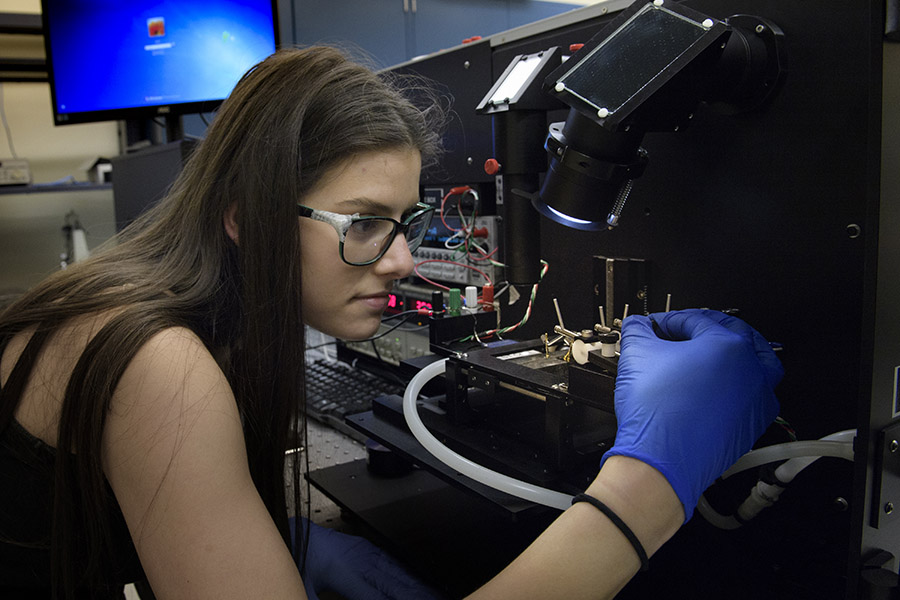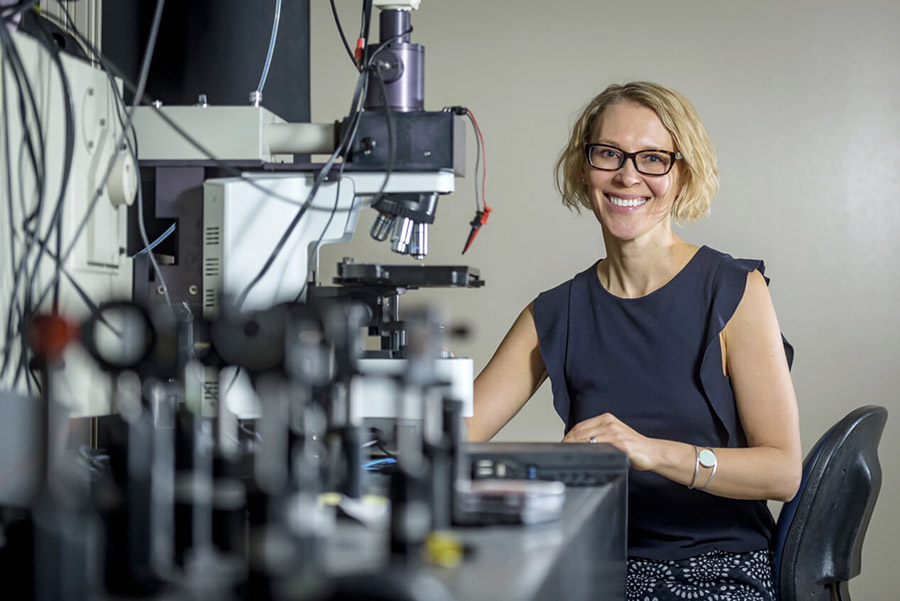Leading Research

Purdue ECE faculty lead many of the University’s leading research centers and initiatives. From programming languages to AI to autonomous systems, microelectronics, and much more, Purdue ECE is collaborating with partners in academia and industry to come up with innovative solutions to the world’s grand challenges.
Center for Programming Principles and Software
This research center aims to connect fundamental research in programming languages (PurPL) and software engineering with domains such as artificial intelligence and cybersecurity. Co-directed by Milind Kulkarni, professor of electrical and computer engineering, and Tiark Rompf, associate professor of computer science, the center will work with its partners in industry and academia to tackle some of the biggest challenges we face. PL research can provide answers to some of the essential questions:
- Robust, explainable, efficient AI
- Formal verification of smart contracts
- Compilers and runtimes for emerging hardware platforms
Affiliated faculty includes experts in PL, covering all areas from theory to systems, as well as eight experts in domains spanning AI, machine learning, security, cryptography, as well as computational science and engineering, with a proven track record of successful collaboration and tech transfer. Current research areas include: PL, Compilers, Formal Methods; Systems, Platforms; Security, Crypto; and Machine Learning, Artificial Intelligence.
Center for Innovation in Control, Optimization and Networks
Affiliated with the broader Purdue’s Strategic Initiative on Autonomous and Connected Systems, the mission of ICON is to integrate diverse expertise across control, optimization and networks to create innovative solutions to grand challenges. Specifically, the center aims to:
- Establish foundational knowledge and develop advanced techniques for controlling and optimizing complex autonomous systems.
- Offer customizable curricula and leverage diverse delivery approaches to meet emerging educational needs.
- Strengthen partnerships with industry, governmental agencies and national labs to tackle national and global priorities.
Co-directed by Shreyas Sundaram, Marie Gordon Associate Professor of Electrical and Computer Engineering, and Shaoshuai Mou, associate professor of aeronautics and astronautics, ICON brings together diverse expertise from across Purdue, blending cutting-edge techniques from machine-learning, AI, and data science with foundational theories from control, optimization, and networks. ICON’s broad research themes include: multi-agent and networked systems; resilient and secure autonomy; human/autonomy interaction; data science, machine learning and AI for autonomy and control; control and optimization of infrastructure systems; and validation and verification of autonomous and connected systems. The ICON team aims to enhance Purdue’s leading role in frontier research topics, and intensify collaboration with industry, funding agencies, and national labs, enabling ICON researchers to address grand challenges facing our world.
Center for Secure Microelectronics Ecosystem
The Center for Secure Microelectronics Ecosystem (CSME) is a first-of-its-kind global partnership of academia, industry and government to advance research and workforce development in designing secure microelectronics. CSME is co-directed by Joerg Appenzeller, Barry M. and Patricia L. Epstein Professor of Electrical and Computer Engineering, and Anand Raghunathan, Silicon Valley Professor of Electrical and Computer Engineering. The center’s aim is to help ensure a secure supply of semiconductor chips and related products and tools, from the foundry to the packaged system, based on a zero-trust model. Purdue secured funding for the consortium from TSMC and Synopsys, Inc., and through collaboration with the DOD-supported Scalable Asymmetric Lifecycle Engagement Microelectronics Workforce Development program (SCALE). CSME provides advanced training opportunities to SCALE participants, while SCALE supports CSME through graduate traineeships, addressing the urgent need for engineering graduates with microelectronics skills. Secure microelectronics is a critical research focus area identified under Purdue’s National Security and Technology Initiative. The initiative, which is part of the University’s Next Moves, is one of five designed to advance the University’s competitive advantage.

Institute for Cognitive Computing
The Institute for Cognitive Computing (ICC) aims to advance the field of cognitive computing through cross-layer innovation spanning brain-inspired computing models, algorithms, architecture, and hardware fabrics. Co-directed by Kaushik Roy, Edward G. Tiedemann Jr. Distinguished Professor of Electrical and Computer Engineering, and Anand Raghunathan, Silicon Valley Professor of Electrical and Computer Engineering, the institute brings together faculty with diverse backgrounds to pursue these goals by facilitating collaborative research and training the next generation workforce in this critical domain. Advances in AI have been enabled in large part by improvements in computing systems. The next generation of AI will require unprecedented computation efficiency, robustness, adaptability to diverse applications and environments. ICC believes that cognitive computing platforms embodying the key principles of biological intelligence will be instrumental in enabling the next wave of pervasive AI.
ECE Emerging Frontiers Center: Crossroads of Quantum and AI
The first Elmore ECE Emerging Frontiers Center, Crossroads of Quantum and AI, builds on Purdue ECE’s seminal, complementary contributions in the areas of machine learning, nano and quantum photonics, neuromorphic computing, large-scale manufacturing and big data. The center is uniquely positioned to achieve preeminence in the proposed effort. Activities are expected to attract increased attention at the government and corporate levels, thus offering a great potential for Purdue ECE to become the leader in merging AI, quantum and beyond.
The rapid emergence of next-generation technologies is currently fueled by the rise of Quantum Information Science and Technologies (QIST), novel large-scale manufacturing approaches, new concepts in Cognitive Systems, as well as Big Data and Artificial Intelligence (AI). Merging these powerful approaches promises to solve fundamental scientific problems and unlock new applications with breakthrough functionalities. There is a critical need to explore both the untapped potential of AI-empowered manufacturing and quantum systems as well as the new generation of robust AI systems, including neuromorphic computing and beyond-CMOS approaches, and physics-driven AI. By combining historically disconnected research areas of quantum, AI, secure cognitive systems and manufacturing, this center aims at advancing both the “physical” and the “virtual” parts of emerging technologies.

Birck Nanotechnology Center
Birck Nanotechnology Center is home to 300 resident students, faculty and staff who have access to 33,000 sq. ft. of shared labs. Research groups come from six academic colleges (engineering, science, agriculture, pharmacy, polytechnic and veterinary medicine). Zhihong Chen, professor of electrical and computer engineering, is the interim director of Birck, which includes one of the largest and cleanest university cleanrooms. Birck is a user facility for an additional 300 users from more than 125 academic units across campus and from outside industries & universities.
Birck faculty bring $25-30M/year in external research funding. Research thrusts include:
- Nanoelectronics and Semiconductor Devices
- Nanophotonics and Quantum Optics
- Sensors/IoT and Nanomanufacturing
- M/NEMS for RF Engineering, Transducers and Sensors
- Bionanotechnology and Nanomedicine
- Energy Conversion and Heat Transfer
- Materials Synthesis and Characterization
Birck is home to the SMART industry consortium, focused on printed low-cost internet of things (IoT) devices; LyoHUB, a consortium of pharmaceutical companies working to improve freeze drying techniques; as well as Microsoft Station Q at Purdue. Birck is leading a $19.8M Lilly Endowment project at Purdue, the Wabash Heartland Innovation Network (WHIN), to develop community IoT testbeds in digital agriculture and in next generation manufacturing in counties surrounding Purdue.
nanoHUB
Founded in 2002, the Network for Computational Nanotechnology (NCN) has pursued its mission to advance nanoscience and nanotechnology through nanoHUB.org. The NCN cyber platform is led by Gerhard Klimeck, principal investigator and professor of electrical and computer engineering. nanoHUB has become the premier open and free platform for computational research, education, and collaboration in nanotechnology, materials science, and related fields. Its mission is to accelerate innovation through user-centric science and engineering and its vision is to make science and engineering products usable, discoverable, reproducible and easy to create for learners, educators, researchers, and business professionals. The site hosts a rapidly growing collection of simulation tools that run in the cloud and are accessible through a web browser. In addition, nanoHUB provides online presentations, nanoHUB-U short courses, animations, teaching materials, and more.
nanoHUB offers researchers a venue to explore, collaborate, and publish content as well. Authors of content published on nanoHUB.org represent a broad and growing cross-section of the nanotechnology community. Their work impacts industry, education, and governmental organizations around the world. The majority of nanoHUB users are affiliated with academic institutions, while other individuals are part of government and industry groups.
